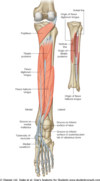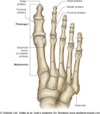Leg and Ankle SDL Flashcards
(96 cards)
How does the tibia articulate with the femur at the knee joint?
The medial and lateral tibial plateaus (condyles) articulate with the medial and lateral femoral condyles at the knee joint
What does the tibia articulate with distally at the ankle joint?
The talus
Where do the tibia and fibula articulate with each other?
The tibia and fibula articulate with each other at their proximal and distal ends
The tibia’s medial surface is extensive and superficial. What 2 clinical procedures is it therefore used for?
- Donor site for bone grafts
- Intraosseous (IO) access
When is IO access used?
In emergencies when the peripheral vasculature is shut down and the superficial veins cannot be cannulated
What type of joint is the IO membrane?
a form of fibrous joint which unites the tibia and fibula
What does the IO membrane separate?
Separates the muscles of the anterior and posterior compartments of the leg (also acts as attachment site for muscles)
What separates the muscular compartments from each other in the leg?
The intermuscular septae

Do the intermuscular septae stretch?
No - are tough and inelastic
What is compartment syndrome?
When pressure builds in legs, intermuscular septae (formed by deep fascia) doesn’t stretch –> vessels and nerves are compressed
There is a foramen in the proximal part of the IO membrane – what passes through it?
Anterior tibial artery
What type of joint is the ankle?
Synovial hinge joint
What forms the ankle joint?
- The distal tibia, distal fibula and the talus
*

The ankle joint is very stable. Can you explain the anatomical basis for this stability?
- Good congruity
- Supporting ligaments
What movements are possible at the ankle?
- Flexion
- Extension
- Eversion
- Inversion
Describe flexion of the foot. What is it also called?
- Toes pointing towards floor
- Also called plantarflexion
- Performed by muscles of posterior compartment
Describe extension of the foot. What is it also called?
- Toes pointing upwards
- Also called dorsiflexion
- Performed by muscles of anterior compartment
In which position - flexion or extension – is the ankle is most stable? Explain your answer.
- In dorsiflexion / extension
- As the trochlear surface of the talus is wider anteriorly
- This forms a wedge that fits between the medial and lateral malleoli making dorsiflexion the most stable position for the ankle.
Where do inversion and eversion of the foot occur?
At the subtalar joint NOT the ankle joint
Is inversion or eversion of the ankle more common?
One of the most common injuries at the ankle is a forced inversion of the foot, which typically occurs when we fall over a kerb or step, or wobble over on the ankle when walking or running on uneven ground.
Which ligament complex is at risk in an inversion injury?
Lateral ligament complex
What can inversion injuries sometimes result in?
Fracture of lateral malleolus (distal fibula)
Which ligament is at risk from eversion injuries?
Medial ligament complex –> deltoid ligament
Why are ligament injuries typically quite slow to heal?
Ligaments are relatively avascular















